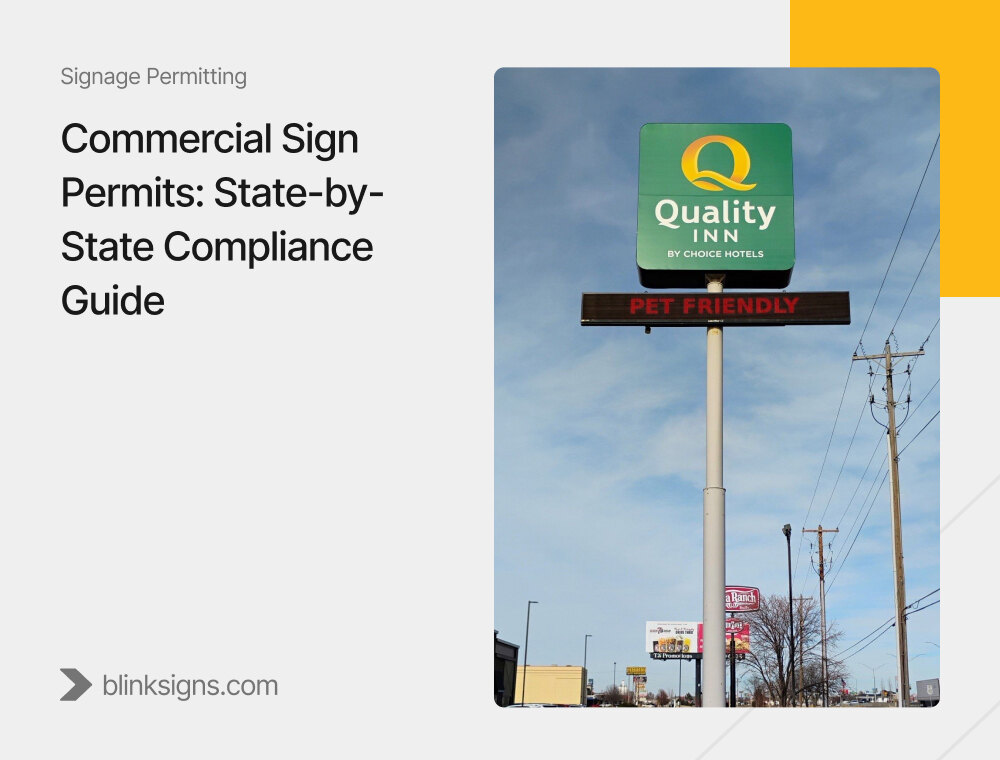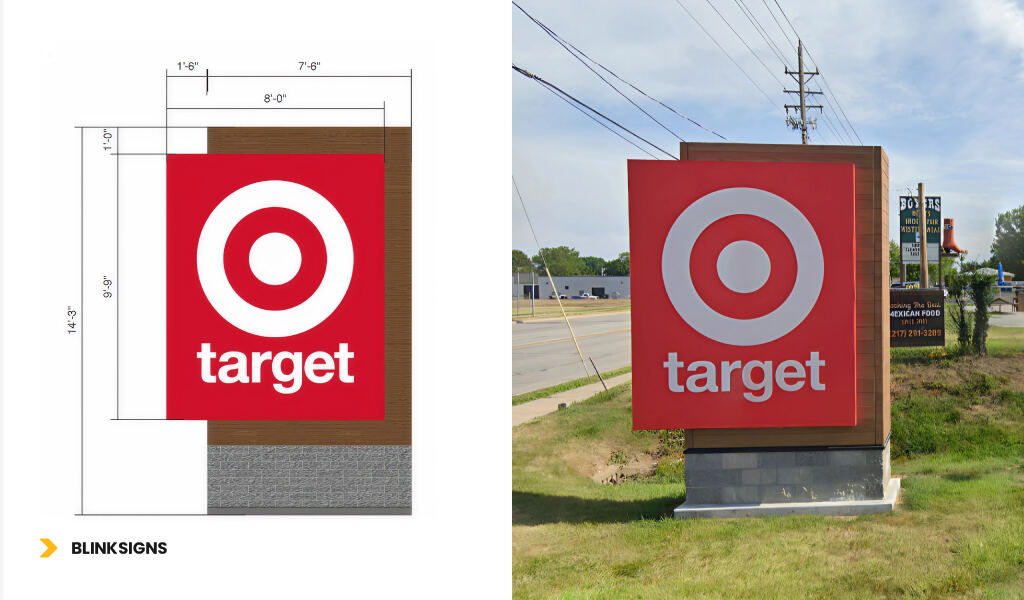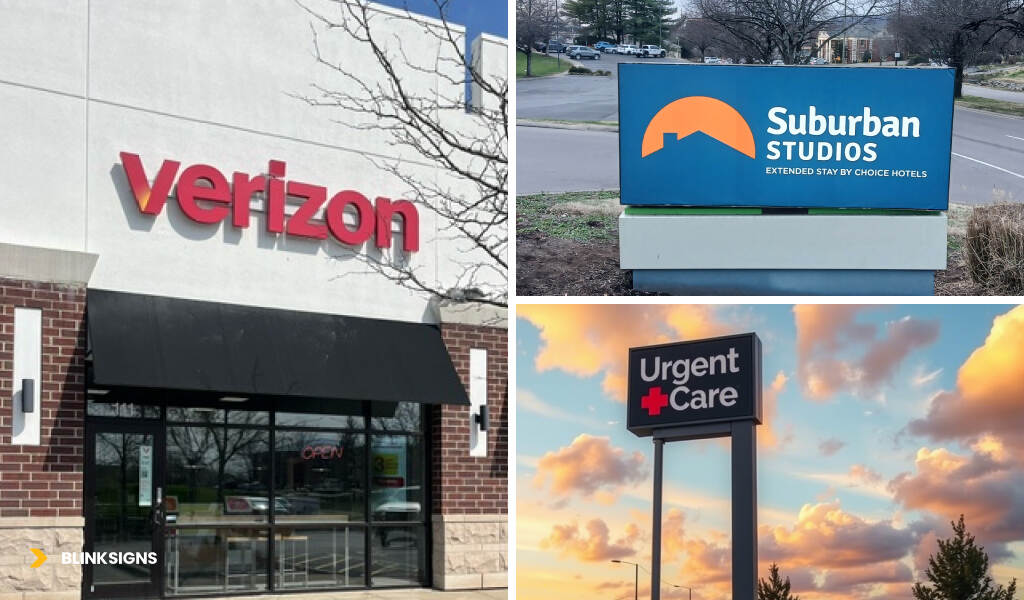
Commercial Sign Permits: State-by-State Compliance Guide
Why Commercial Sign Permits Matter for Businesses
Every sign your business installs tells a story, about your brand, your professionalism, and your place in the community. But before a sign goes up, there’s a critical step that too many businesses overlook: securing the proper commercial sign permits.
Failing to comply with local and state requirements can mean more than fines, having your sign removed, disrupting your brand visibility, and wasting your investment. For businesses operating across multiple states, this becomes even more complex. Each municipality has its rules for sign size, height, illumination, placement, and materials.
That’s where BlinkSigns steps in. With years of expertise navigating sign codes, zoning boards, and city planning departments, we simplify the process so you can focus on growth while we handle the compliance.
What Are Commercial Sign Permits?

What Are Commercial Sign Permits_
A commercial sign permit is an official approval from a local government or zoning authority that allows your business to install, modify, or maintain signage. These permits regulate:
- Size and placement: Ensuring your sign doesn’t obstruct traffic or violate property lines.
- Illumination levels: Preventing glare and light pollution.
- Safety standards: Confirming structural integrity and electrical compliance.
- Aesthetics: Aligning signage with community character or historic district guidelines.
Signs that almost always require permits include:
Core Elements of the Sign Permit Process
Before we dive into state-specific breakdowns, it helps to understand the general framework of a permitting process:

The Process Of Commercial Sign Permit
Application Requirements
- Submitting scaled drawings, material specifications, and property site plans.
- Often requires both landlord approval (for leased properties) and city review.
Zoning and Code Compliance
- Zoning ordinances regulate maximum height, square footage, and setback requirements.
- Certain districts—like downtowns or residential-adjacent zones—enforce stricter rules.
Variance Applications
- Businesses must apply for a variance if a proposed sign exceeds the standard code.
- Typically requires a public hearing and planning commission approval.
Inspections and Final Approvals
- Structural checks for wind loads and foundations.
- Electrical inspections for illuminated or digital signs.
- ADA verification for accessibility signage.
State-by-State Commercial Sign Permit Regulations
California Sign Permits
California’s mix of historic cities, coastal communities, and dense urban environments creates one of the most complex signage regulatory landscapes in the U.S.
- Los Angeles: Highly detailed sign codes restrict supergraphics, billboards, and digital displays. Many areas fall under Supplemental Use Districts (SUDs) with unique rules.
- San Francisco: Known for strict preservation efforts—historic districts often require signs to blend seamlessly with architectural character. Variance approvals are standard.
- San Diego: Enforces size limitations for commercial signs in coastal zones and requires illumination checks to limit light pollution.
California demands early planning, detailed drawings, and often multiple agency approvals. Businesses here benefit from professional permit management to avoid costly delays.
Texas Sign Permits
Texas is business-friendly, but that doesn’t mean signage is unregulated. Statewide rules from TxDOT govern highway-facing signs, while cities apply additional zoning controls.
- Houston: Applies strict regulations on billboards and digital LED displays, requiring special permits for illumination levels.
- Dallas: Enforces height and square footage caps in urban zones; variances are needed for oversized pylon structures.
- Austin: Prioritizes eco-conscious signage. Certain districts promote sustainable materials and restrict high-intensity lighting.
Texas offers flexibility, but urban centers still enforce precise limits. Highway-facing businesses should prepare for TxDOT-specific restrictions.
Florida Sign Permits
With frequent hurricanes and tropical weather, Florida codes emphasize structural safety and wind resistance. Most cities require engineering stamps for large freestanding signs.
- Miami: Permission is required for almost all illuminated signage, with added restrictions in historic districts like Little Havana.
- Orlando: Businesses near theme parks must comply with special overlay zoning rules, including limits on digital messaging.
- Tampa: Enforces height restrictions for signs near waterfronts and requires storm-proofing for pylon and monument installations.
Florida signage permitting is as much about safety and resilience as aesthetics. Engineering approvals are critical to pass inspections.
New York Sign Permits
New York has some of the most detailed sign regulations in the country, especially in New York City, where signage contributes to both safety and streetscape preservation.
- New York City (NYC): Signs must comply with the NYC Zoning Resolution and often require Department of Buildings (DOB) approval and Community Board review. Illuminated signs need electrical permits, and oversized displays in Times Square fall under specialized zoning overlays.
- Buffalo & Albany: More flexible but still mandate square footage limits in residential-adjacent districts.
- Key nuance: Many New York municipalities enforce permit renewals every 1–2 years, unlike other states, where approval is permanent.
In New York, permitting isn’t just a one-time process — it’s an ongoing compliance requirement.
Ohio Sign Permits
Ohio’s diverse urban centers and suburban growth mix means businesses must navigate city-specific rules layered over state building codes.
- Columbus: Requires permits for all freestanding and illuminated signs; overlays apply in the Arena District and historic neighborhoods.
- Cleveland: Emphasizes ADA and safety compliance—electrical permits are required for channel letters, digital, and neon signage.
- Cincinnati: Strict in the downtown core, where architectural harmony is prioritized. Historic districts often demand board approvals.
Ohio is detail-heavy regarding historic preservation, requiring professional design packages to pass city reviews.
Illinois Sign Permits
Illinois municipalities enforce clear distinctions between on-premise and off-premise signage.
- Chicago: One of the strictest cities in the Midwest — permits are required for all commercial signs over 6 square feet. Public way use permits may also be required if the sign extends into city property.
- Springfield & Peoria: Balance structural safety with size caps, requiring engineering for large pylon and monument structures.
- Statewide: The Illinois Department of Transportation (IDOT) regulates signs near highways, focusing on spacing and visibility safety.
Illinois emphasizes public property use and transportation safety, making professional submissions essential.
Nevada Sign Permits
Nevada’s signage landscape reflects its hospitality-driven economy, especially in Las Vegas, where signs are part of the city’s identity.
- Las Vegas: Known for iconic displays, but even here, regulations exist. The city restricts digital brightness levels, enforces safety inspections, and requires permits for changes in messaging or LED displays.
- Reno: More modest rules but still mandates engineering checks for freestanding signs due to high winds.
- Clark County: Oversees permits for areas outside city limits, including many resort corridors.
Nevada is permissive creatively, but businesses must comply with illumination and engineering codes for approval.
Commercial Sign Permits: State-by-State Comparison
| State | Key Governing Authority | Permit Scope | Special Considerations | Average Approval Time | Unique Compliance Factors |
| California | Local municipalities (e.g., Los Angeles Dept. of Building & Safety, SF Planning) | Required for most permanent, illuminated, and structural signs | Historic districts in SF require extra approvals; ADA enforcement is strict | 4–12 weeks | Coastal zones & historic overlays add extra review layers |
| Texas | City zoning & building departments (e.g., Dallas, Houston) | Freestanding, pylon, monument, and illuminated signs | Houston exempts billboards in some zones but enforces size/height caps | 2–6 weeks | Wind-load requirements due to storm exposure |
| Florida | Local municipalities + FDOT (near highways) | Illuminated, structural, and off-premise signs | Coastal areas impose hurricane safety engineering | 2–8 weeks | Brightness limits for LED/digital signage in Miami/Dade & tourist corridors |
| New York | NYC DOB, local zoning boards | All permanent and illuminated signs; public-way encroachment permits | NYC requires renewal every 1–2 years; historic boards in specific neighborhoods | 6–16 weeks | Unique overlays for Times Square; annual/bi-annual renewal requirements |
| Ohio | City building depts. (e.g., Columbus, Cleveland, Cincinnati) | Illuminated, freestanding, and historic-area signage | Historic preservation overlays in Cleveland/Cincinnati require board approval | 3–10 weeks | Heavy focus on ADA/tactile compliance in healthcare zones |
| Illinois | Local municipalities + IDOT (highways) | All signs over six sq. ft. in Chicago; off-premise signs are regulated | Chicago requires public way use permits if extending onto city property | 4–12 weeks | IDOT enforces spacing/safety near highways statewide |
| Nevada | City/county zoning & planning (e.g., Las Vegas, Reno, Clark County) | Illuminated, digital, and large freestanding signs | Las Vegas enforces brightness limits on LED signs | 2–8 weeks | Resorts require structural engineering for high-wind safety compliance |
How to Use This Table
- Business Owners: Identify your state’s key authority and unique compliance hurdles before designing signage.
- Multi-Location Brands: Plan for longer lead times in states like New York and California, where historic and zoning reviews are intensive.
- Hospitality & Retail Chains: Pay attention to renewal requirements (NY) and engineering mandates (Florida & Nevada).
⚡ Pro tip: BlinkSigns manages this complexity for you. With nationwide permitting expertise, our team handles drawings, engineering, submissions, and compliance tracking so your project stays on time and code.
Industry-Specific Permit Challenges

Industry-Specific Permit Challenges
Different industries face unique permitting hurdles.
- Retail Chains: Variances are often needed for oversized pylon signs or multiple storefront identifiers.
- Healthcare Facilities: Must meet ADA wayfinding compliance — tactile, Braille, and clear directional signage require detailed approvals.
- Hospitality & Hotels: Many states apply height restrictions to illuminated rooftop signs.
- Franchises: Consistency is critical, but sign codes vary — requiring local adaptations without diluting brand identity.
Technology & Trends in Permit Management
The permitting process is evolving, with new technology streamlining compliance.
- Digital Submissions: Many cities now accept online applications and digital plan sets, reducing paperwork delays.
- GIS Mapping Integration: Local governments use mapping tools to enforce zoning overlays and spacing requirements.
- Predictive Compliance Tools: AI-driven tools forecast approval likelihood based on past permit data, helping businesses reduce application risks.
- Centralized Permit Management: BlinkSigns offers centralized tracking dashboards for multi-location businesses, ensuring consistent compliance across states.
FAQs on Commercial Sign Permits
- Do all signs require a permit?
Not all. Temporary banners and minor interior window signs often don’t, but permanent, illuminated, or structural signs almost always do. Local ordinances determine exemptions. - How long does it take to get a sign permit approved?
Approval can take anywhere from 2 weeks to 3 months, depending on the city, complexity, and whether variances are required. Historic districts add extra review time. - What happens if I install a sign without a permit?
You risk fines, forced removal, or loss of a business license. Unpermitted signs sometimes become legal liabilities during accidents or property sales. - Can a sign permit be denied?
Yes. Common reasons include zoning conflicts, exceeding size/height limits, improper illumination, or failure to meet ADA and safety standards. - Who handles the permitting process?
Many businesses partner with experienced firms like BlinkSigns, which manage drawings, submissions, code checks, and inspections from start to finish.
Permits as a Strategic Step, Not a Roadblock
Commercial sign permitting can feel overwhelming, especially for businesses operating in multiple states. But compliance isn’t just a legal necessity — it’s a safeguard for your brand visibility, investment, and safety.
At BlinkSigns, we simplify this journey. Our team navigates local codes, state regulations, and zoning boards so your signs get approved — and keep performing. From California’s strict historic reviews to Nevada’s LED illumination rules, we manage every detail with precision and foresight.
Your signs aren’t just structures but investments in visibility and brand reputation. With proactive compliance, you protect those investments and eliminate costly risks.
👉 Partner with BlinkSigns to ensure your signage project meets every standard, passes every inspection, and reflects your brand at its best.